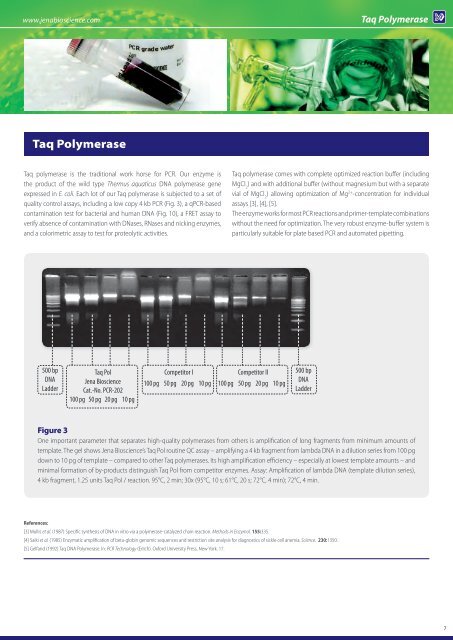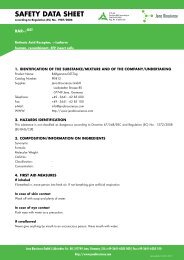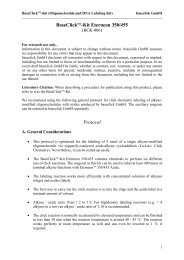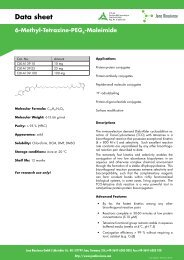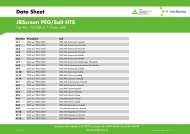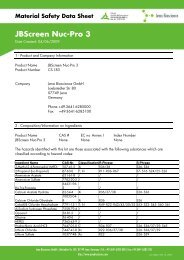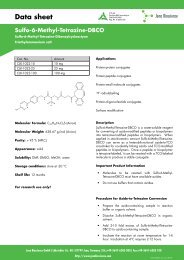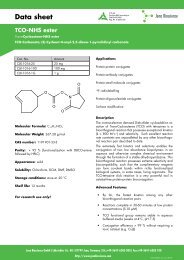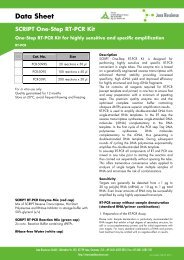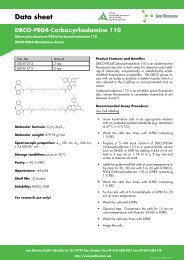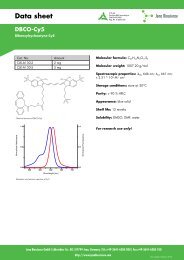Polymerase Guide - Jena Bioscience
Polymerase Guide - Jena Bioscience
Polymerase Guide - Jena Bioscience
You also want an ePaper? Increase the reach of your titles
YUMPU automatically turns print PDFs into web optimized ePapers that Google loves.
www.jenabioscience.com Taq <strong>Polymerase</strong><br />
Taq <strong>Polymerase</strong><br />
Taq polymerase is the traditional work horse for PCR. Our enzyme is<br />
the product of the wild type Thermus aquaticus DNA polymerase gene<br />
expressed in E. coli. Each lot of our Taq polymerase is subjected to a set of<br />
quality control assays, including a low copy 4 kb PCR (Fig. 3), a qPCR-based<br />
contamination test for bacterial and human DNA (Fig. 10), a FRET assay to<br />
verify absence of contamination with DNases, RNases and nicking enzymes,<br />
and a colorimetric assay to test for proteolytic activities.<br />
500 bp<br />
DNA<br />
Ladder<br />
Taq Pol Competitor I Competitor II<br />
<strong>Jena</strong> <strong>Bioscience</strong><br />
Cat.-No. PCR-202<br />
100 pg 50 pg 20 pg 10 pg<br />
100 pg 50 pg 20 pg 10 pg 100 pg 50 pg 20 pg 10 pg<br />
Taq polymerase comes with complete optimized reaction buffer (including<br />
MgCl 2 ) and with additional buffer (without magnesium but with a separate<br />
vial of MgCl 2 ) allowing optimization of Mg 2+ -concentration for individual<br />
assays [3], [4], [5].<br />
The enzyme works for most PCR reactions and primer-template combinations<br />
without the need for optimization. The very robust enzyme-buffer system is<br />
particularly suitable for plate based PCR and automated pipetting.<br />
500 bp<br />
DNA<br />
Ladder<br />
Figure 3<br />
One important parameter that separates high-quality polymerases from others is amplification of long fragments from minimum amounts of<br />
template. The gel shows <strong>Jena</strong> <strong>Bioscience</strong>’s Taq Pol routine QC assay – amplifying a 4 kb fragment from lambda DNA in a dilution series from 100 pg<br />
down to 10 pg of template – compared to other Taq polymerases. Its high amplification efficiency – especially at lowest template amounts – and<br />
minimal formation of by-products distinguish Taq Pol from competitor enzymes. Assay: Amplification of lambda DNA (template dilution series),<br />
4 kb fragment, 1.25 units Taq Pol / reaction. 95°C, 2 min; 30x (95°C, 10 s; 61°C, 20 s; 72°C, 4 min); 72°C, 4 min.<br />
References:<br />
[3] Mullis et al. (1987) Specific synthesis of DNA in vitro via a polymerase-catalyzed chain reaction. Methods in Enzymol. 155:335.<br />
[4] Saiki et al. (1985) Enzymatic amplification of beta-globin genomic sequences and restriction site analysis for diagnostics of sickle cell anemia. Science. 230:1350.<br />
[5] Gelfand (1992) Taq DNA <strong>Polymerase</strong>. In: PCR Technology (Erlich). Oxford University Press, New York. 17.<br />
7


